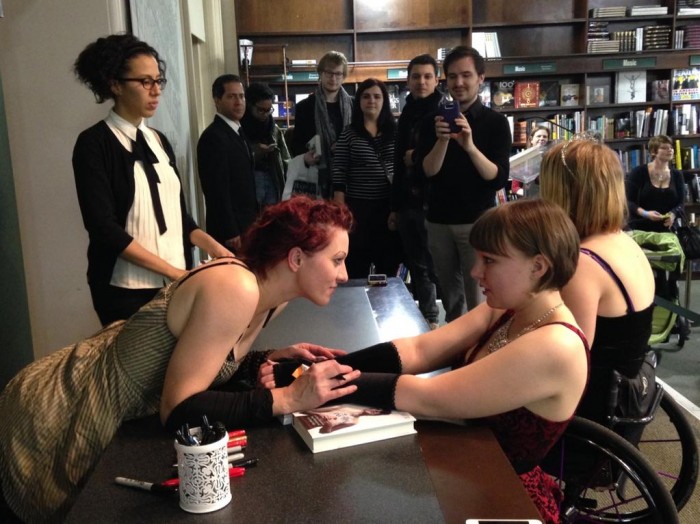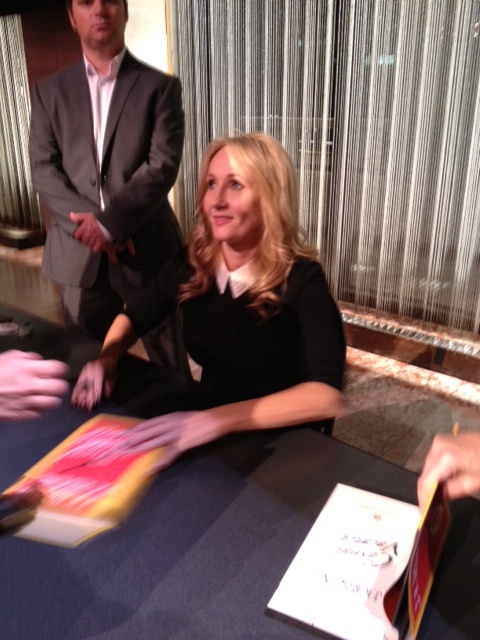You are a writer. You are an artist. You are an entrepreneur. You are a creative professional of some sort.
What is the goal of pursuing your work? What does this look like in real-life?
There could be many drivers for what you create, including validation, self-expression, helping others, adding more to the world than you took away from it, or so many other reasons. When considering how we represent “success”, we often assign placeholders; things such as bestseller lists, awards, or massive financial rewards to illustrate achievement.
But I saw a photo this week that perfectly embodies not just what we often hope to achieve, but how powerful this can be to those who experience your work:

Credit: Jimmy Franco of Grand Central Publishing
This is Amanda Palmer (left), meeting a fan of hers, Sarah Staalesen (right), at a book signing in New York City. This photo is engrossing to me in so many ways. The setting is typical for managing a large crowd who came to see a single person. There were loads of folks there to see Amanda at an event which was part of the launch of her book, The Art of Asking. You can see the white tape on the floor, the rope designed to create boundaries between people. There are handlers in the background trying to ensure books are placed correctly for signing, etc.
When I met J.K. Rowling at a similar event years ago, she had a bodyguard next to her. He wasn’t an especially large man, but his job was to stand just over her right shoulder and observe:

This video of Lady Gaga’s bodyguards identifying and “neutralizing” what they saw as a potential threat always stuck with me – that the casual man behind Ms. Rowling likely had skills I couldn’t imagine (and never want to witness.)
I find this image an interesting contrast to the photo of Amanda and Sarah. Sarah seems to have fallen to her knees. Amanda is out of her chair, leaning over the table, embracing Sarah’s arms, and looking intently into her eyes. She breaks all normal physical and emotional barriers in this process.
For the body of work that you are creating, this is the goal: a deep human connection between two people, the writer and the reader; the artist and the viewer; the musician and the listener; the designer and the user.
This is the effect you hope for after creating the work itself. After you write the book; after you put down your paint brush; after the gallery hangs your art.
Yes, I am always clear that creating a quality body of work is the most important step, and the first step. But after this happens, the focus often turns to connecting it to others.
I talk to a lot of writers and creative professionals, and occasionally run into someone who is 100% focused on submitting their work to awards I have never heard of. The idea is that the validation of these awards is fulfilling, and will ultimately encourage others to experience their work. It also provides the identity of “award-winning author.”
I also see folks who focus intently on gaming Amazon’s algorithms so that they can spend four minutes as the top spot on a sub-sub-sub bestseller list. This, provides the identity of “bestselling author.”
Now, winning awards and being on bestseller lists is really cool. I’m for these things. But they are not THE goal. They are merely stand-ins for the experience represented in the photo above.
The real goal is that moment when a fan connects so deeply with your work, that in the moment where they meet you, that it looks something like the photo above. It is a place where the boundary of artist and fan is broken, and you are two human beings sharing something unique together.
Sarah connected with me via email, and told me about her experience meeting Amanda:
“I nervously knelt down in front of the desk, lost for words as Amanda began speaking to me, complimenting my outfit and asking what my name was. Then there was hesitation, because I have always been very bad at answering that question.”“I don’t like my name,” I quickly blurted. My face was tomato-red.”
“Why don’t you like your name?” Amanda was so gentle with her questions.”
“I was not able to give her a proper answer because that would take up way too much time, and I had already froze by then, and I didn’t want to have her waiting all night. I was silly to say anything in the first place. “It’s Sarah,” I was finally able to say after a lot of stammering.”
“Then, very suddenly, she leaned forward to look into my face & took my wrists into her hands, and of course I was speechless. She was seeing me. I don’t have a lot of experience with really being seen. It was breathtaking and shocking to be held by Amanda.”
“My face started to crumple. “I’m sorry, I can’t look at you without crying.”
“Just try to,” she answered.”“As she saw me deeply, I saw her as well. No more words were exchanged. I couldn’t even remember to breathe. After the moment, she signed the books I brought and blew me a kiss goodbye. My heart was soaring & I was quick to blow one back, hurrying off the stage for the next fan, feeling light as air, and ready to have a happiness-induced breakdown.”
Now, I know that some of you reading this blog post, and may be cringing at the idea of needing to physical embrace those who read and experience your work. You expressly DON’T want to have to touch fans — you want the work itself to do that. I get this. And of course, you 100% get to choose what you create, how you create it, and how it connects with the world.
You don’t have to wear arm warmers as Amanda does, and you don’t have to reach across the table to embrace fans.
But Amanda chooses to. This choice is hers. This choice creates meaningful moments, and I have to say, it’s pretty inspiring. This is how she pitched her appearance in New York: “Just come and hang out. I will leave no human unhugged.”
Writers and other creative professionals are often overwhelmed with ideas for how to connect their work to the world. They may look for “marketing tactics that scale,” such as publicity, social media, getting reviews, blog tours, book tours, strategic partnerships, events, giveaways, bestseller lists, awards, and so much more.
Now, these things are good, and I work with authors every day on many of them. But I never lose sight of the goal: that real human connection between a writer and a reader, via their work. And that the 1:1 connection creates a powerful effect in the world.
I haven’t yet read Amanda’s new book The Art of Asking, but I will soon. In the meantime, this interview between her and Maria Popova is well worth your time.
How do you encourage one-to-one connections with those who experience the work you create?
Thank you.
-Dan
